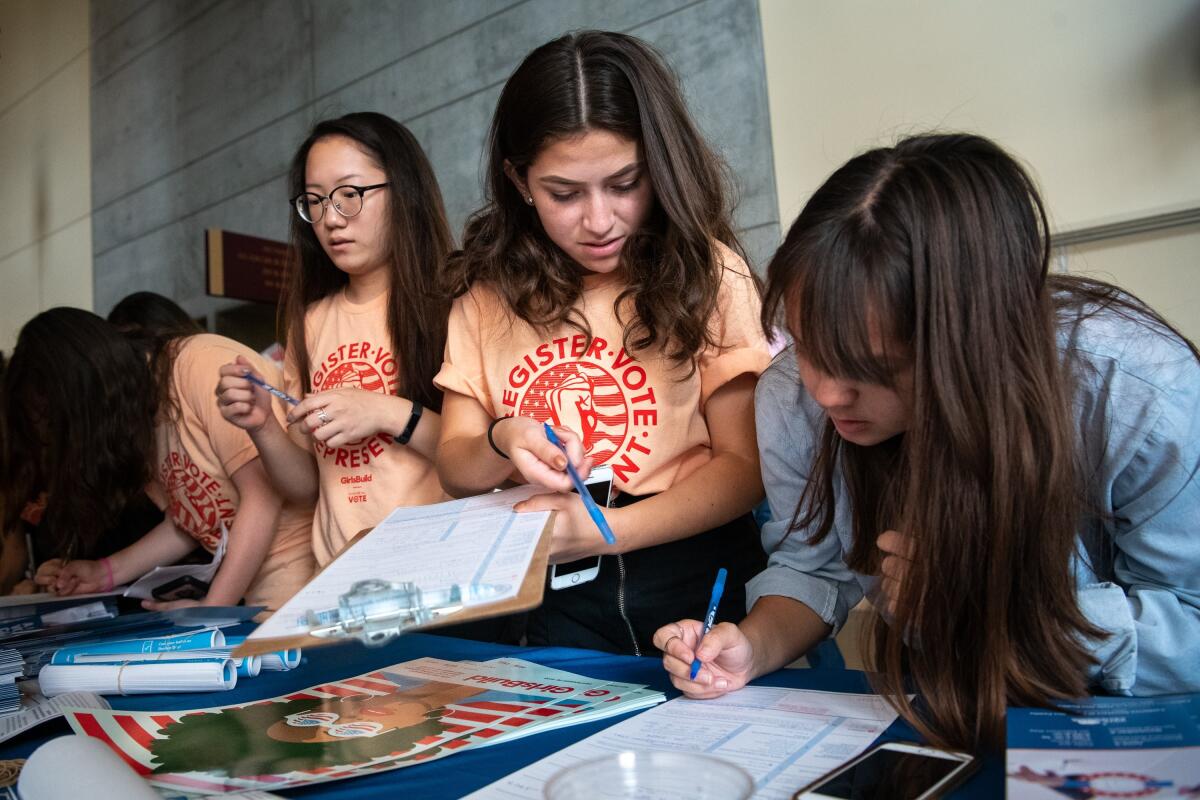Op-Ed: What California can learn from Georgia about increasing youth voter turnout

Georgia showed the nation that it’s possible to do much more to encourage young people to support democracy. Through the work of community activists and groups, the share of voters under 25 more than doubled in the Georgia electorate between 2016 and 2020.
California could learn from Georgia, a state where a strict voter ID law creates obstacles for young voters and does not allow people to preregister to vote until they turn 17½.
California does not have those barriers, and yet the share of registered voters ages 17½ to 25 in the California electorate has barely changed from 2016 to 2020. In California, we allow preregistration beginning at age 16, but we have little ability at the state, local or school district level to make sure this happens. In the last two years, the number of high school students who are preregistered to vote in California has actually declined by more than 5% statewide, going from 131,298 to 123,875 preregistered voters. In Los Angeles County, the number of students preregistered has declined 7% compared with two years ago (from 29,592 to 27,517).
In California, we have most of the technical apparatus that voting rights advocates champion. We have online voter registration and automatic voter registration at the Department of Motor Vehicles, as well as preregistration beginning at age 16. What we don’t have are the social systems we need to make these laws work.
In the Los Angeles Unified School District, the nation’s second-largest school district, administrators asked high schools in August to comply with state law by identifying a person responsible for voter registration and offering a variety of resources to help with voter engagement efforts. Still, as of October, across all school districts in Los Angeles County only 11% of 16- and 17- year-olds had preregistered to vote.
What is missing in California and most of its school districts is a requirement that high schools help their students register, provide a strong civics curriculum, train teachers in every high school, provide necessary funds and measure results, school by school. Here are some steps the state could take that could make a significant difference.
The Legislature should reintroduce AB 773, a 2019 bill that would have required public high schools to help students register or preregister to vote and to teach students about the voting process. The bill passed the Legislature but was vetoed by Gov. Gavin Newsom on the grounds that it imposed a one-size-fits-all requirement on every high school. That criticism can be addressed by allowing schools to carry out the requirement in ways suitable to their specific population and educational traditions.
Texas teens and 20-somethings are voting early in huge numbers. They exemplify a trend around much of the nation, where the youth vote is powering record-setting early balloting.
The state should improve the online voter registration system, which currently requires users to have a driver’s license or state ID to avoid a cumbersome process of linking the voter’s signatures with their registration records. Many young people do not drive, and with the COVID-19 pandemic, many DMV offices statewide were temporarily closed or offered only limited services in 2020. The state could streamline the online system (as Pennsylvania has) to allow people to upload a signature in the online registration process and confirm their citizenship by a sworn statement and the last four digits of their Social Security number. Paper voter registration forms in California do not require submission of a state ID, and the online system should not be more burdensome.
The state could also administer automatic voter registration in a better way to accommodate young voters. In the current system, residents who are eligible to register or preregister to vote are automatically registered when they engage with the DMV unless they opt out. However, many young people get a learner’s permit at 15½ — and therefore are not old enough to be automatically preregistered through the DMV when they get the permit. Yet when they take their driver’s tests after they turn 16, the DMV’s computer system does not recognize this as a new transaction that should result in automatic preregistration. Young voters thus routinely fall through the cracks of an automatic preregistration system intended to benefit them. Fixing this problem would require little more than better coordination between the DMV and the secretary of state.
In addition to changing laws and updating state systems, we also need to provide support for nonprofit groups that focus on democracy to educate and bring high schoolers into the voting process. Young people turn 18 every year, whether or not there is an election. Funding preregistration efforts consistently, not only in election years, is the best way to lay the groundwork.
The 2020 elections showed the impact that comes from increasing voter registration and turnout, especially among young voters. To make more voices count, California needs to be reaching young people where they are.
Laura W. Brill is the founder and director of the Civics Center, an L.A.-based nonpartisan organization dedicated to high school voter registration and civic engagement. Vicki C. Shapiro is the organization’s director of special initiatives. The Civics Center is a project of Community Partners.
More to Read
A cure for the common opinion
Get thought-provoking perspectives with our weekly newsletter.
You may occasionally receive promotional content from the Los Angeles Times.











